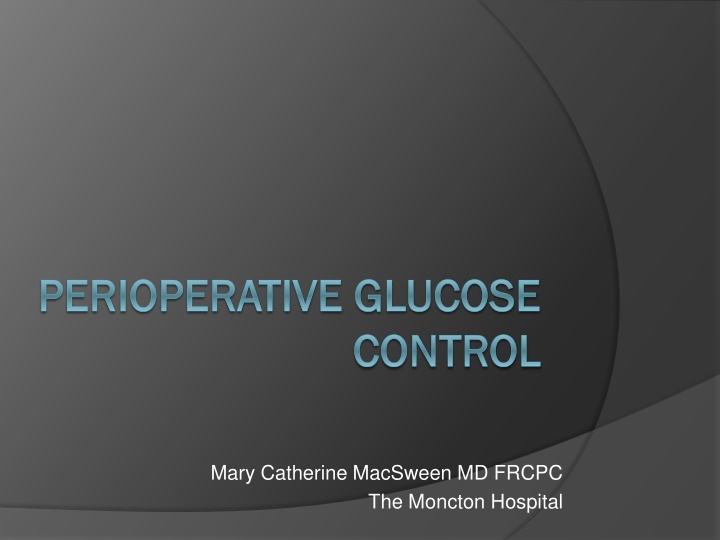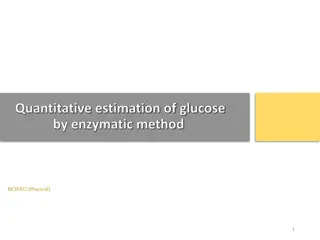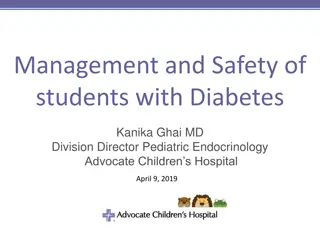Perioperative Glucose Control in Diabetes Management
Managing perioperative glucose levels is crucial for patients with diabetes to prevent complications and improve outcomes. This case-based scenario discusses strategies for perioperative glucose control in different diabetic patients, emphasizing the importance of monitoring and individualized treatment approaches to achieve optimal glycemic control before, during, and after surgery.
Download Presentation

Please find below an Image/Link to download the presentation.
The content on the website is provided AS IS for your information and personal use only. It may not be sold, licensed, or shared on other websites without obtaining consent from the author.If you encounter any issues during the download, it is possible that the publisher has removed the file from their server.
You are allowed to download the files provided on this website for personal or commercial use, subject to the condition that they are used lawfully. All files are the property of their respective owners.
The content on the website is provided AS IS for your information and personal use only. It may not be sold, licensed, or shared on other websites without obtaining consent from the author.
E N D
Presentation Transcript
PERIOPERATIVE GLUCOSE PERIOPERATIVE GLUCOSE CONTROL CONTROL Mary Catherine MacSween MD FRCPC The Moncton Hospital
Case DM 74 year old male DM1 x 40 years. MDI with Levemir 17 units hs and NovoRapid at meals. Pre-op instructions take half usual Levemir hs. Pre-op glucose 17.8 mmol/L. Day 2 given half dose again at hs. Day 3, ICU on 8 units/hr insulin drip.
Case GR 56 year old woman in PACU Friday afternoon post elective TKR. DM 2 x 8 years. Rx Metformin, Januvia and Gliclazide. Pre-op: A1c 10.4% and Fasting BG 13.7 mmol/L. Call endo could you see Monday am?
Case MM A 52 year old male is admitted unresponsive with a subarachnoid bleed. He has known childhood onset DM 1 and adult obesity and is on an insulin pump and metformin. Blood glucose in ER is 6.0 mmol/L and repeated in NICU is 5.6 mmol/L. What would you do?
Diabetes in New Brunswick Hospitals Diabetes? 27%? New Brunswick Bed Days
Hyperglycemia in Inpatients Hyperglycemia, regardless of prior diagnosis of diabetes, is a marker of poor clinical outcome. New hyperglycemia is an independent marker for increased mortality, especially in non-ICU patients. Hyperglycemia is associated with prolonged hospital stay, infection, disability after hospital discharge and death.
Hyperglycemia: a Common Comorbidity in Medical-Surgical Patients in Hospital Normoglycemia Known DM New Hyperglycemia 16% mortality 1.7% mortality 3% mortality Umpierrez JCEM 2002
Criteria to diagnose diabetes A1C > 6.5% FBG > 7.0 mmo/L Classic symptoms and random glucose >11 mmol/L
Sebranek et al BMJ Dec 2013 Glycemic control in the Glycemic control in the perioperative period perioperative period
Undiagnosed Diabetes in Surgical Patients 7310 German patients undergoing CABG 5.2% had undiagnosed DM. More likely to require resuscitation, re- intubation, and longer postoperative ventilation and had higher perioperative mortality than both diagnosed diabetes and no diabetes. 2010 Cleveland Clinic study found the rate of undiagnosed DM in ~ 40,000 non-cardiac surgery patients was 10% and IFG 11%.
Preoperative A1C Colorectal surgery 120 patients without known DM followed prospectively. (2009) A1C > 6% were at significantly increased risk for pneumonia, UTI, pleural effusions and post operative ileus. Retrospectively, A1C <7% significantly associated with decreased pneumonia, wound infection UTI and sepsis. (2006) Orthopedic Surgery Significant increase in wound complications after total knee arthroplasty in diabetic patients with A1C > 8% (2013) Preadmission hyperglycemia independent risk factor for in-hospital symptomatic PE after major orthopedic surgery. (2010)
Hyperglycemia and Post Operative Thromboembolic Disease Retrospective study of 6500 hip/knee replacement surgeries. Post op PE hyperglycemic vs. normoglycemic patients a 3.9 x risk. Mraovic, Can J Anaes. June 2007
Consensus Conference 2004 American Association Clinical Endocrinologists American College of Endocrinology Endocrine Society ADA AHA Society of Critical Care Medicine Society of Hospital Medicine Society of Thoracic Surgeons American Society of Anesthesiologists American Association of Diabetes Educators
The incidence of diabetes has tripled over the last decade and one third are undiagnosed. Diabetic patients are at increased risk for postoperative infection, arrhythmia, acute renal failure, stroke, MI, increased LOS, and death. Stress-induced hyperglycemia entails higher risks and often poorer outcomes in hospitalized patients than equally dysglycemic patients with known diabetes.
Sliding Scale Insulinle Glucose Control BG (mmol/L) 16.5 What do you do? +6 U What do you do? +4 U 14.0 Sliding Scale alone BG (mmol/L) Bolus insulin (U) 10.0 < 4 Call MD 4.1 10.0 0 10.1 13.0 2 13.1 16.0 4 6.0 6.0 16.1 19.0 6 4.0 What do you do? 0 U What do you do? 0 U > 19.0 Call MD 3.0 Breakfast Lunch Dinner Bedtime Bolus insulin QID QID: four times daily; SSI: sliding-scale insulin; BG: blood glucose CDA: In Hospital Diabetes, CPG 2013
BASAL + BOLUS + CORRECTION Results in Smoother Glycemic Control 6+2 U Correctional Insulin AC meals What do you do? 12.0 BG (mmol/L) Bolus insulin (U) 10.0 < 4 Call MD 6+0 U What do you do? 4.1 10.0 0 What do you do? 10.1 13.0 2 13.1 16.0 4 6.0 18 U 6.0 6.0 What do you do? 6+0 U 4.0 16.1 19.0 6 > 19.0 Call MD Bedtime Breakfast Lunch Dinner Basal insulin 6U 6U 6U ROUTINE Bolus insulin Routine Basal
Subcutaneous Insulin Order Set Breakfast Supper HS Basal Continue if not eating ___ units ___ units ___ units Breakfast Lunch Supper Prandial Do not give if not eating ___ units ___ units ___ units Low dose < 40 units/d Medium dose 40-80 units/d High dose > 80 units/d Half dose HS Adjustmen t Scale Half dose at hs
Common Pitfalls of Insulin COS Looks too complicated . All aspects of insulin orders not on one page. Lack of an embedded hypoglycemia protocol. Institute of Hospital Medicine
Distribution of Basal vs. Prandial 20% 20% 20% Basal 40 50%
Physiologic Insulin Replacement Basal Insulin drip (R) Insulin pump (H or NR) Intermediate acting insulin NPH N Long acting insulin Lantus (glargine) Levemir (detemir)
Insulin Orders Basal Insulin Nutritional Correction
In-Hospital Glycemic Targets Patient Type Glucose Target (mmol/L) Non-critically ill Fasting 5-8* Random <10* Critically ill 8-10 CABG intraop 5.5-10 Other periop 5-10 CABG = coronary artery bypass graft; IV = intravenous; Intraop = intraoperative; periop = perioperative *As long as targets can be safely achieved
Perioperative Glycemic Targets WHO Surgical Safety Checklist bundle: target blood glucose of 6 -10 mmol/L (acceptable range 4 12 mmol/L.)
When is Sliding Scale Alone OK? When high risk for hyperglycemia and starting TPN or steroids. Well controlled diabetes on lifestyle alone or monotherapy with oral agent on hold for surgery. If holding multiple agents start basal 0.3 units/kg.
Surgery Ward - Early Results Glucometer Readings Pre/Post Clinical Order Set 5600 Pilot Project Before After : (significant improvement) Percentage 14 % >12 12 10 8 % <3.4 6 4 2 0 Nov 20-26 (total=175) Nov 27-Dec 3 (total=111) Dec 4-10 (total=120) Dec 11-17 (total=332) Dec 18-24 (total=193) Dec 25-31 (total=53) Jan 1-7 (total=128) Week
5600 COS Pilot Poster Canadian Association of Hospital Pharmacists Nine months after implementation, the percentage of CBG > 10mmol/l fell 20%. Hypoglycemia CBG < 3.4mmol/l remained very low (0.2 to 1.0%). Use of basal insulin significantly increased. Surgical site infections decreased.
Case DM 74 year old male DM1 x 40 years. MDI with Levemir 17 units hs and NovoRapid at meals. Pre-op instructions take half usual Levemir hs. Pre-op glucose 17.8 mmol/L. Day 2 given half dose again at hs. Day 3, ICU on 8 units/hr insulin drip.
Addition to Insulin Order Set for NPO Patients PRE-OP NPO: Give usual dose of Lantus of NPH OR Reduce night time NPH or Lantus by 20%. AM of procedure reduce AM NPH by 50% or Lantus/Levemir by 20% and HOLD other scheduled insulins.
Case GR 56 year old woman in PACU Friday afternoon post elective TKR. DM 2 x 8 years. Rx Metformin, Januvia and Gliclazide. Pre-op: A1c 10.4% and Fasting BG 13.7 mmol/L. START multiple daily injections of insulin with basal and prandial and correction on insulin order set.
When to Start an Insulin Drip Blood glucose > 11 mmol/L start insulin drip for 48h (especially if STEMI). Need an insulin order set aiming for glucose level of 8.0 10.0 mmol/L Depending on A1C and clinical parameters start oral agents or multiple daily injections of insulin when drip stopped.
Proposed Addition to IV Insulin Order Set For transition from insulin drip to subcutaneous insulin: STOP insulin drip 30 - 60 minutes after first injection of Rapid acting or Regular insulin 2 hours after first dose of NPH or Lantus (if no Rapid/R given). Ensure basal insulin is ordered if insulin drip dose >1 units/hr in patient not on home insulin (i.e. 40% of total daily insulin drip dose as basal +/- 0.1 unit/kg Rapid insulin at each meal).
Case MM A 52 year old male is admitted unresponsive with a subarachnoid bleed. He has known childhood onset DM 1 and adult obesity and is on an insulin pump and metformin. Blood glucose in ER is 6.0 mmol/L and repeated in NICU is 5.6 mmol/L. What would you do?
Case MP Scenario 1 A. Stop the pump. B. Continue the pump. C. Call a friend.
TECHNOLOGIES TECHNOLOGIES
When Should Insulin Pump Therapy be Stopped? During prolonged surgical procedures. When post-op analgesic requirements are expected to be high. In patients unable to reliably count carbs, monitor glucose and use pump functions.
OmniPod Insulin Pump Tubeless Pump . Glucose meter is remote control but basal will infuse automatically. Holds 200 units. Patch pumps to come for DM2
Non-Pump Insulin Delivery Devices V-Go dual Chamber Patch Pen Insulin Patch Pens























